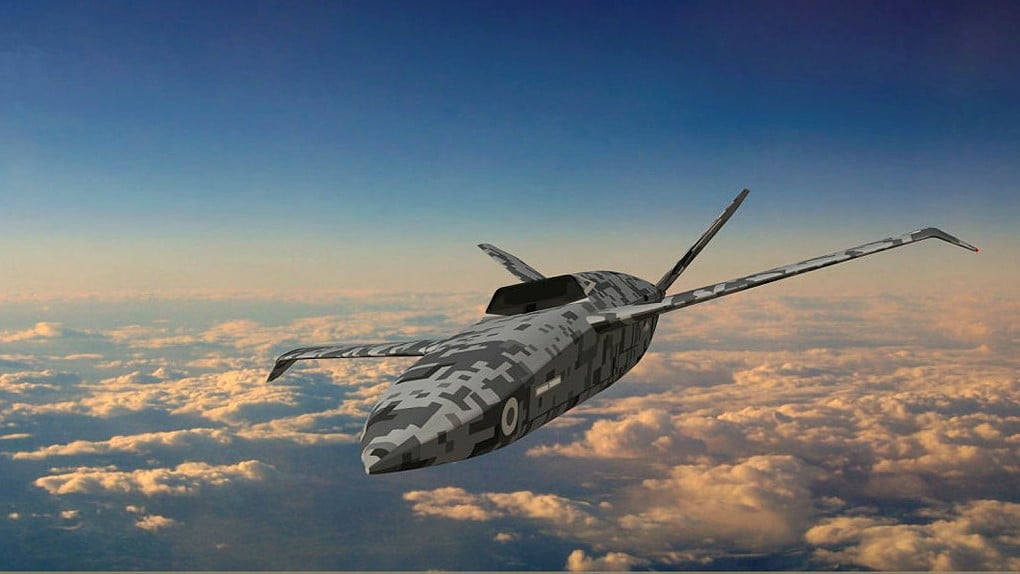
Computer Generated Image of the Lightweight Affordable Novel Combat Aircraft (LANCA). (UK MoD)
WASHINGTON — Unlike the F-35 program, which saw three US military branches and a handful of international partners involved in its creation, the US Air Force’s next-generation fighter will be developed independently, with many of its key attributes kept secret.
However, Air Force officials have hinted there may be opportunities for the US and its allies to co-develop technologies that could be “associated” with future tactical aircraft — specifically the Collaborative Combat Aircraft (CCA) drones that will operate alongside the Next Generation Air Dominance (NGAD) manned fighter, as well as the mission systems inside the fighter itself.
“There may be some international partnerships associated with NGAD,” said Air Force Secretary Frank Kendall last month at the Defense News conference. Kendall added that international cooperation will be “very limited” to the United States’ closest allies and partners, but early discussions have begun to take shape — particularly on potential collaboration on the CCA program.
“I just came back from visiting both Australia and Japan, and earlier in the year I was in the United Kingdom,” he said. “We’ve had some preliminary conversations with all those countries about their interest. There seems to be a lot of interest in the uncrewed Collaborative Combat Aircraft.”
The US Air Force plans to field its next-gen air superiority aircraft as part of the NGAD “family of systems,” which will include some assortment of various CCA drones, and next-generation weapons and mission systems.
During a meeting this July at the Royal International Air Tattoo, Air Force Chief of Staff Gen. CQ Brown said he and his UK counterpart, Air Chief Marshal Michael Wigston of the Royal Air Force, talked “conceptually” about potential collaboration opportunities.
“There’s probably some opportunity [for co-development] as you go forward with various mission systems, as we work NGAD and the UK works Tempest,” Brown said in a recent interview with Breaking Defense. Tempest is the UK’s sixth-generation fighter program, which will be part of a family of systems similar to NGAD.
Although the discussion did not define specific areas where the two air forces could co-develop technologies, Brown said that NGAD’s open mission system backbone could provide greater opportunity to “drive competition” among international defense companies throughout the lifecycle of the program.
If the US Air Force is looking to partner with foreign nations on facets of NGAD, the UK, Australia and Japan are the perfect starting points for those discussions given those countries’ history of high-end air superiority requirements and the deep pockets necessary to pay to accomplish that mission, said Richard Aboulafia, an aerospace analyst with AeroDynamic Advisory.
The big question is: “Does anybody in the Air Force really want to adapt their requirements to somebody else’s?” Aboulafia said. “I don’t think so. But that doesn’t mean there aren’t opportunities for cooperation.”
Last year the UK and Japan signed an agreement to co-develop an engine demonstrator for Tempest and the Japanese F-X program. While the US Air Force is unlikely to enter this project — it’s developing its own NGAD engine under the Next Generation Advanced Propulsion effort — Japan and the UK are also jointly working on an air combat sensor suite known as Jaguar that could be of interest to the United States.
And in the realm of unmanned aviation, the United Kingdom is interested in operating combat drones that can partner with Tempest, and is developing a Loyal Wingman-style drone as part of the Lightweight Affordable Novel Combat Aircraft effort.
Aboulafia said that both the UK and Japan have other technology specialties that could further feed into future mission systems and drones. For instance, the UK’s Rolls Royce and BAE Systems are leaders in the areas of aircraft propulsion and electronic warfare, respectively.
Meanwhile Japan could be a little bit of a wild card in terms of what it has to offer.
“Japan, years ago, they were really up front with the first AESA [active electronically scanned array] radar and the first co-cured composite wing on the F-2,” but in subsequent years have not emphasized developing leap-ahead defense technology, Aboulafia said. One area Japan could emerge as a technology innovator is in the realm of artificial intelligence, “a key missing variable” for CCA.
Meanwhile Australia has been investing in its own Loyal Wingman-style drone, the MQ-28 Ghost Bat, in which Kendall has expressed interest. Unlike the UK’s drone development efforts, the Royal Australian Air Force has already begun flying and experimenting with MQ-28 prototypes, which are made in Australia by Boeing — a US pedigree that could help generate buy in from the US Air Force.
Australia has traditionally not had a large defense industry, but it’s growing “and [unmanned aviation] is what they’re emphasizing,” Aboulafia said.






















